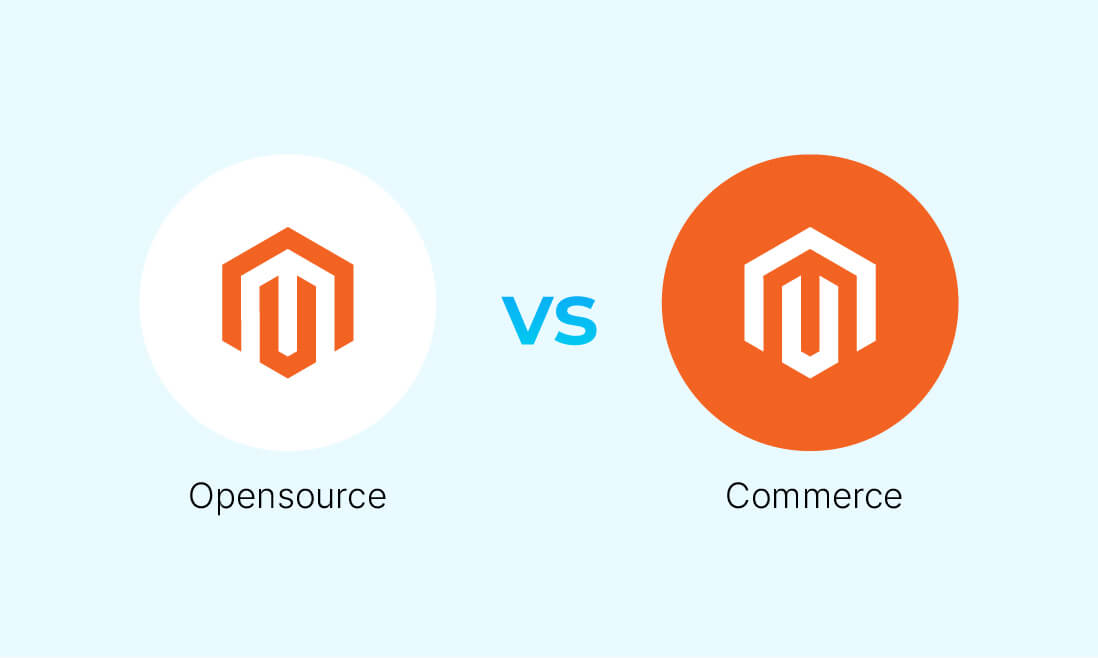Are you trying to decide between Magento Open Source and Adobe Commerce for your online store?
It’s like choosing between two great tools in a toolbox, each with its own strengths. Magento Open Source is like a trusty hammer – free, straightforward, and great for many jobs. Adobe Commerce, on the other hand, is more like a power drill – it costs more, but it’s packed with features that can take your business to the next level.
In this post, we’re going to dive into both options. We’ll look at what they offer in terms of features, how much they’ll cost you, and the kind of support you can expect from each. This comparison will help you figure out which tool is right for the job.
What is Magento Open Source?
Magento Open Source, which used to be called Magento Community Edition until 2017, is a key player in the e-commerce world. It’s a favorite for many online businesses because it’s free and works really well for creating online stores.
This version is a part of Adobe Commerce, but it’s free and open-source, making it a great choice for small businesses. It allows for adding extra features and extensions, which can really boost an online store’s capabilities.
One of the biggest reasons why Magento Open Source is so popular is its strong community. Thousands of people download and test it every month. This community is not just about numbers; it’s filled with dedicated developers who love to share tools and help each other out. This is the heart of what makes open-source projects special – everyone working together and sharing knowledge.
However, to make the most of Magento Open Source, you need some technical skills. If your team knows how to code and can handle things like hosting, managing the website’s back end, then this option might be perfect for you. But remember, adding new features can take time, and that might slow down how quickly you can grow your business.
What is Adobe Commerce?

Adobe Commerce takes everything from Magento Open Source to the next level. It’s more than just an e-commerce platform; it’s a complete enterprise solution that caters to businesses looking for advanced features and greater control over their online presence.
As a paid offering from Adobe, Adobe Commerce includes all the high-end features you would expect in a top-tier e-commerce platform. It combines robust functionality with the ability to scale limitlessly. This makes it ideal for businesses operating in the complex and ever-evolving world of digital commerce. With Adobe Commerce, you can stay ahead of growing customer demands and market trends.
Adobe Commerce Cloud is the cloud edition of Adobe Commerce. It includes all the features of Adobe Commerce along with enhanced Adobe Cloud infrastructure hosting. This setup allows developers to work more efficiently, with environments for development, staging, and production. This means smoother performances and quicker deployments.
Both Adobe Commerce and Adobe Commerce Cloud are tailored for large enterprises with complex needs. They offer a broad range of powerful admin features, ensuring flexibility and scalability.
Magento Open Source vs Adobe Commerce: Features
When it comes to choosing between Magento Open Source and Adobe Commerce, understanding the features each offers is crucial. Let’s dive into a comparison to help you make an informed decision.
Magento Open Source Key Features:
- Integrated checkout, payment, and shipping
- Catalog management
- Site search
- WYSIWYG page builder
- Extended functionality through the App Marketplace
Magento Open Source provides a solid foundation for small businesses looking to establish an online presence. It offers essential tools for modern eCommerce stores, and store owners can add more integrations or extensions if needed. While it’s a robust platform out of the box, some of the more advanced features found in Adobe Commerce are not included.
Adobe Commerce Key Features:
- All features of Magento Open Source
- Complete B2B suite (quotes, company accounts, etc.)
- Advanced content management (drag-and-drop with staging/preview)
- Business intelligence dashboards
- Advanced marketing tools
Adobe Commerce, being a paid offering from Adobe, includes high-end features expected in a top-tier e-commerce platform. It integrates seamlessly with other Adobe services, providing a comprehensive customer experience. The platform is well-suited for larger businesses or enterprises with complex requirements.
Key Differences:
- Marketing Tools: Adobe Commerce has an edge with integration capabilities with Adobe Experience Manager and other Adobe services, offering a superior customer experience.
- Reporting and Analytics: Adobe Commerce provides built-in tools for deeper business insights, whereas Magento Open Source requires third-party integrations for similar functionalities.
- Exclusive Modules: Adobe Commerce boasts exclusive features like Live Search powered by Adobe Sensei, seller-assisted shopping, a complete B2B toolset, and more.
- Performance: Adobe Commerce has specialized performance enhancements, particularly beneficial for large-scale operations.
Remember, both platforms share a common codebase, so the choice often boils down to your specific business needs and the level of complexity you’re willing to manage.
Magento Open Source vs Adobe Commerce: Pricing

Another critical factor to consider is pricing. Understanding the cost implications of each option is essential for making an informed decision that aligns with your business needs and budget.
Magento Open Source Pricing:
- Estimated Cost: Free
- Magento Open Source is entirely free to download and use. It’s a community-driven open-source project, making it an attractive option for small to medium-sized businesses or startups.
- While the platform itself doesn’t have any licensing fees, you should consider potential costs related to hosting, customization, third-party extensions, and potentially higher developer costs if you need specialized features that aren’t available out of the box.
Adobe Commerce Pricing:
- Estimated Cost: $22,000 to $125,000 per year (varies based on gross sales revenue)
- It’s important to note that the exact pricing for Adobe Commerce is not explicitly outlined and can vary. The fee is a percentage of your total annual revenue.
- A key point to remember is that license fees for Adobe Commerce can often be negotiated. This means that two different merchants might end up paying different fees for the same service, depending on their negotiation.
- Keep in mind that if your revenue is relatively low, you will still be subject to the minimum license fee. For some businesses, especially those not expecting rapid growth, this minimum cost may be prohibitively expensive.
When comparing the two, it’s not just about the upfront or annual costs. It’s also crucial to consider the value each platform brings to your business.
Magento Open Source vs Adobe Commerce: Support

When evaluating Magento Open Source and Adobe Commerce, the level and type of support available for each platform is a critical consideration, especially if you have limited expertise in website design and e-commerce.
Magento Open Source Support:
- Level of Support: Community-based
- Magento Open Source does not offer official technical support from Magento or Adobe. This means there is no dedicated customer success care or official technical assistance for this version.
- Support primarily comes from the Magento community. This includes developer communities, guide libraries, and community forums where users can seek help and advice. The community is large and active, offering a wealth of shared knowledge and experience.
- For those without experience in website design, partnering with a web design agency might be beneficial. These agencies can develop your e-commerce site and offer ongoing support.
- Magento Open Source users can also attend Meet Magento community events and participate in various Slack groups and discussion forums for support and networking.
Adobe Commerce Support:
- Level of Support: Comprehensive and professional
- Adobe Commerce offers extensive technical support for its users. This includes customer success care, cloud onboarding support, and 24/7 global support.
- Users benefit from proactive support solutions like a dedicated account manager and technical assistance available round the clock to troubleshoot all store-related issues.
- Adobe Commerce’s support comes under a paid plan from Adobe, which includes service-level agreements (SLAs) to ensure timely and effective support responses.
- Adobe Commerce users also benefit from access to the same Magento community as Open Source, leveraging the collective knowledge and expertise of developers and agencies familiar with both platforms.
Both Magento Open Source and Adobe Commerce benefit from strong third-party module support, with a wide selection of modules available for both platforms. However, since Adobe Commerce operates under a commercial license, there are no modules that extend its built-in functionality beyond what’s already provided.
Both versions have access to the official Adobe Commerce Developer Documentation site. Despite its name, the site offers valuable information applicable to both Magento Open Source and Adobe Commerce. The site is a comprehensive resource for Magento programming, although navigating through the vast amount of information can be challenging.
Which Version Should You Choose?
Deciding between Magento Open Source and Adobe Commerce depends on various factors including your business size, technical expertise, budget, and specific e-commerce needs.
You Should Choose Magento Open Source If:
- Your Business is Small to Medium-Sized: Ideal for startups or small to medium businesses looking to establish an online presence without a hefty investment.
- Budget Constraints: Perfect for those operating with a tighter budget. While the platform is free, be prepared for potential costs related to hosting, customization, and extensions.
- Need for Basic Yet Scalable E-commerce Features: Provides essential e-commerce functionalities, with the flexibility to add more features through extensions as your business grows.
You Should Choose Adobe Commerce If:
- Your Business is Large or Complex: Suited for larger enterprises or businesses with complex e-commerce needs requiring a comprehensive solution.
- Higher Budget for Advanced Features: Ideal for businesses with a larger budget that can justify the investment in advanced e-commerce functionalities and professional support.
- Requirement for Advanced E-commerce Features: If your business needs sophisticated e-commerce features out-of-the-box, including AI-driven tools, a complete B2B suite, advanced content management, and business intelligence dashboards.

